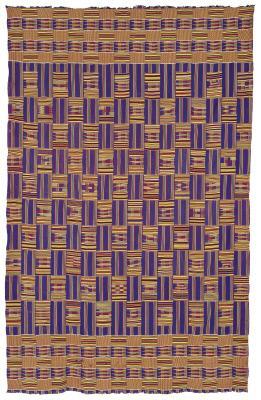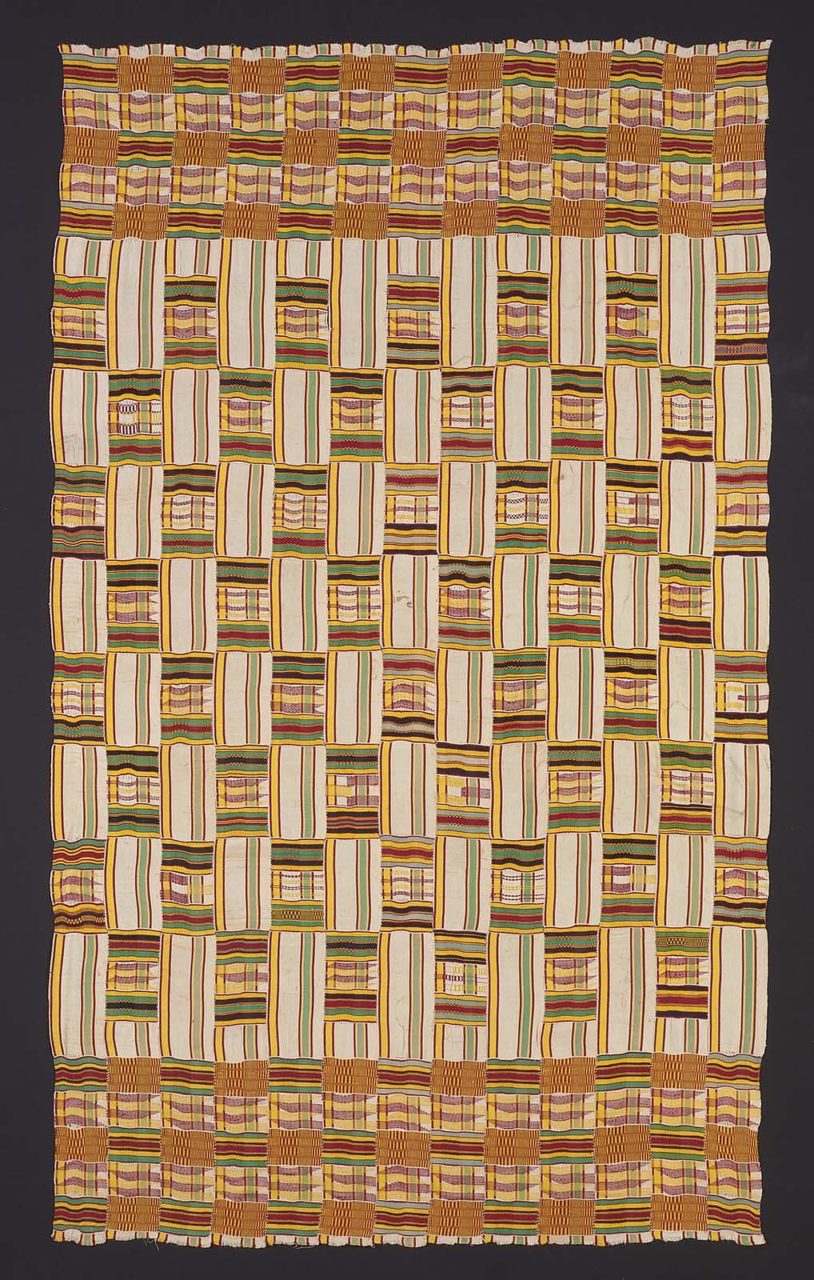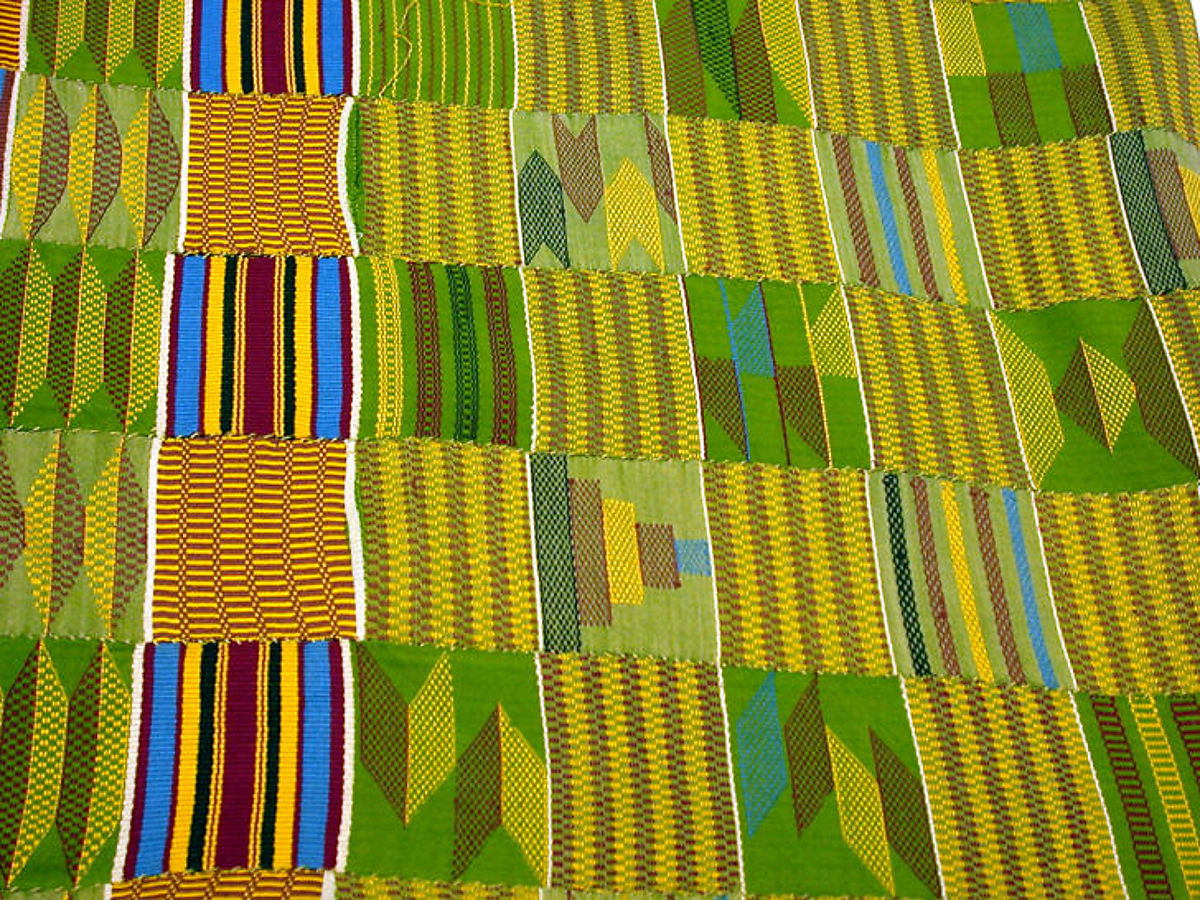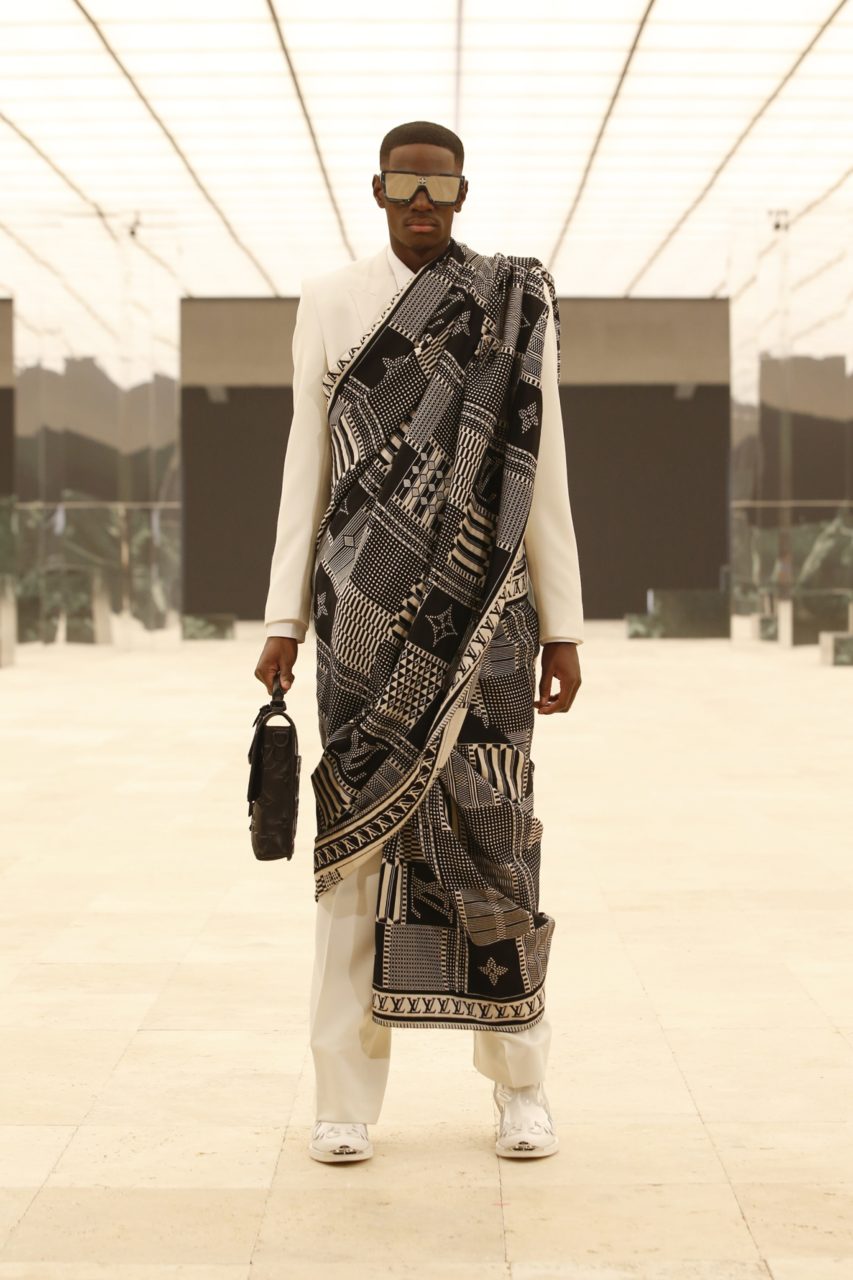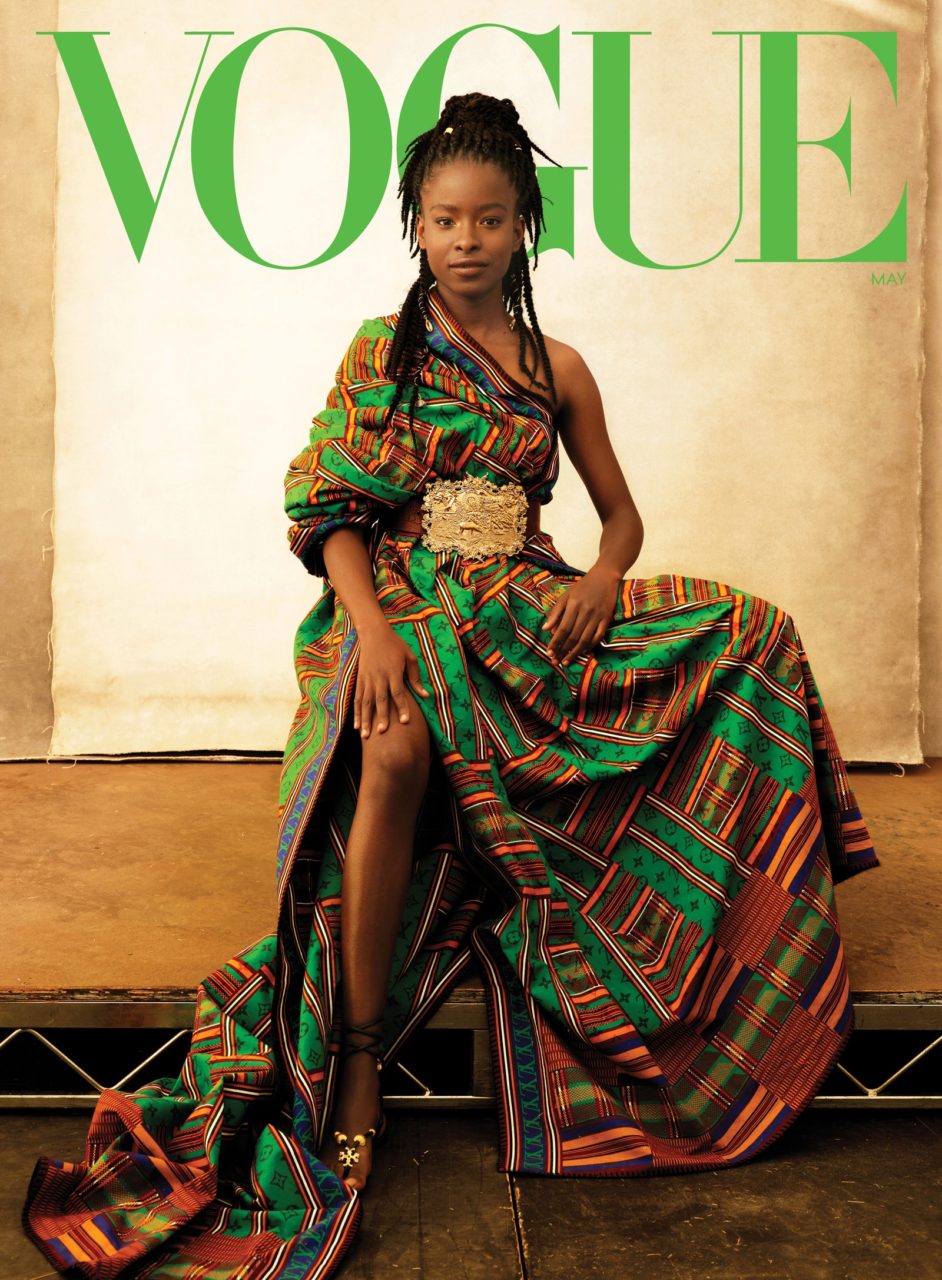Kente is a Ghanaian strip woven textile that has striped patterns and bright colors with corresponding meanings.
The Details
According to kente expert Doran Ross in Wrapped in Pride: Ghanaian Kente and African American Identity (1998):
“Kente cloth is probably the most universally recognized of all African fabrics. The word ‘kente’ means basket, and the cloth is so-named because of its resemblance to a woven basket design. The Asante peoples of Ghana and the Ewe of Ghana and Togo weave it on horizontal, narrow-strip, men’s treadle looms.” (299)
Daniel Delis Hill’s History of World Costume and Fashion (2001) explains that:
“More than 300 named patterns of kente have been documented, one of which, called adweneasa, is so complex that the name literally means ‘my skill is exhausted.’ Some patterns involved the blending of cotton and silk to produce glistening, vividly colored designs. Since the Second World War, kente cloth is frequently woven of less costly rayon to achieve the same silky effect.” (264)
Kente cloth given its long history and prestige is often worn by high-ranking figures. The Seattle Museum has a kente cloth (Fig. 1) that includes a mmeeda pattern that translates to “something unheard of, unprecedented, extraordinary” which was worn by Kwame Nkrumah, the first Prime Minister and President of Ghana. As the museum explains:
“The names given to Asante kente vary: named after important chiefs, queen mothers, historical events, plants, animals, and proverbs.
Kente is most frequently seen at festivals in southern Ghana and Togo and has its origins in the regalia of the Asante and other Akan groups. By the late nineteenth century it was often found in non-royal arenas and by the end of the twentieth century it was available to anyone who could afford it.”
The Metropolitan Museum of Art has a 19th-century silk and cotton kente woven in green, yellow, and red colors, shown draped over a man’s shoulder as it is typically worn (Fig. 2).
Fig. 1 - Designer unknown (Ghanaian). Kente cloth (mmeeda, 'something that has not happened before'), 20th Century. Silk; 306 x 194 cm. Seattle: Seattle Art Museum, 81.17.434. Katherine White and the Boeing Company. Source: Seattle Art Museum
Fig. 2 - Designer unknown (Asante). Kente Prestige Cloth, 19th Century. Cotton, silk. New York: Metropolitan Museum of Art, 1972.56.1. Purchase, Irene Lewisohn Bequest, 1972. Source: The Met
Fig. 3 - Designer unknown (Ghana). Man's wrapper (kente), 20th century, 20th Century. Cotton, rayon, and dye; (130 3/4 x 90 5/16 in). Princeton: Princeton University Art Museum, 1998-697. Source: Princeton Art Museum
Fig. 4 - Designer unknown (Ghanaian). Cloth (kente), 20th Century. Rayon and silk; (79 x 46 in). Boston: Museum of Fine Arts, 2009.2730. Gift of Geneviève McMillan in memory of Reba Stewart. Source: MFA
In the Berg Encyclopedia of World Dress and Fashion: Africa (2010), Lisa Aronson gives several examples of other named kente designs:
“One highly valued kente cloth, sika futuro, meaning ‘gold dust,’ gets its name from its prevailing gold background or field of color…. A kente cloth bearing a black-and-white-striped warp bears the name kyeretwie, meaning the ‘lion or leopard catcher.’ Said to symbolize courage and bravery, this particular kente was designed by a nineteenth-century Asante king who encouraged warriors working under his leadership to catch leopards as proof of their valor and bravery.”
These motifs within kente can be seen in the Princeton University Art Museum’s large, 27-strip men’s wrapper (Fig. 3) that includes motifs of nnwötoa, meaning “snail’s bottom” and nkyɛmfrɛ “broken pots.”
The Museum of Fine Arts Boston has a smaller kente cloth (Fig. 4) that was made for a woman with white, gold, and green motifs and stripes. A close-up of the Met’s kente allows the bold colored stripes and woven motifs typical of kente to be easily seen (Fig. 5).
Fig. 5 - Designer unknown (Asante). Kente Prestige Cloth, 19th Century. Cotton, silk. New York: Metropolitan Museum of Art, 1972.56.1. Purchase, Irene Lewisohn Bequest, 1972. Source: The Met
Its Afterlife
K ente cloth is still being used today in fashion. Many designers from Africa and specifically Ghana use kente in their designs and is often seen on the runway (Fig. 6). It is also still worn in Ghana for political and celebratory events.
As the Seattle Museum of Art notes:
“In America, kente has emerged as a potent symbol of identification with Africa. A kente cloth, or its representation, is seen at African American graduations or other ceremonies honoring people for their accomplishments.”
White American Democratic leaders wearing kente stoles gifted by the Congressional Black Caucus (Fig. 7) caused controversy in 2020, when they were worn to an event honoring George Floyd (Givhan).
British/Ghanaian designer Virgil Abloh’s Louis Vuitton’s fall/winter 2021 men’s collection included several kente pieces that incorporated the LV logo (Figs. 8-9). Amanda Gorman wore a Louis Vuitton kente piece by Abloh using the same textile as one of the menswear looks on the cover of the May 2021 Vogue issue (Fig. 10).
Fig. 6 - Lumiere Couture. Kente on the runway, 2018. SDR Photo / Reze Bonna. Source: The Designer's Studio
Fig. 7 - Manuel Balce Ceneta/AP. Congress, June 2020. Source: Washington Post
Fig. 8 - Virgil Abloh (British/Ghanaian, 1980-). Louis Vuitton Men's Collection, Fall 2021. Source: Vogue
Fig. 9 - Virgil Abloh (British/Ghanaian, 1980-). Louis Vuitton Men's Collection, Fall 2021. Source: Vogue
Fig. 10 - Virgil Abloh (British/Ghanaian, 1980-). Amanda Gorman (Vogue cover), May 2021. Photo by Annie Leibovitz. Source: Vogue
References:
- Givhan, Robin. “Perspective | Congress’s Kente Cloth Spectacle Was a Mess of Contradictions.” Washington Post. www.washingtonpost.com, https://www.washingtonpost.com/lifestyle/2020/06/09/congresss-kente-cloth-spectacle-was-mess-contradictions/. Accessed 4 Apr. 2021.
- Hill, Daniel Delis. History of World Costume and Fashion. Upper Saddle River, N.J.: Prentice Hall, 2011. http://www.worldcat.org/oclc/768100950
- Ross, Doran H, and Agbenyega Adedze. Wrapped in Pride: Ghanaian Kente and African American Identity. Los Angeles: UCLA Fowler Museum of Cultural History, 1998. http://www.worldcat.org/oclc/39905097
- Rovine, Victoria L. “Fashion in African Dress.” In Berg Encyclopedia of World Dress and Fashion: Africa, edited by Joanne B. Eicher and Doran H. Ross, 62–67. Oxford: Berg Publishers, 2010. http://dx.doi.org/10.2752/BEWDF/EDch1010.
- Seattle Art Museum. “Kente Cloth: (Mmeeda, ‘Something That Has Not Happened Before’).” Accessed April 2, 2021. https://localhost/objects/7987/kente-cloth-mmeeda-something-that-has-not-happened-befor;jsessionid=36991A2A85E8D0842461DAF017943CBF.
-
Vogue. “Virgil Abloh Tells the Story Behind Amanda Gorman’s Louis Vuitton ‘Vogue’ Cover Look.” Accessed April 9, 2021. https://www.vogue.com/article/virgil-abloh-louis-vuitton-amanda-gorman-vogue-cover-dress.


